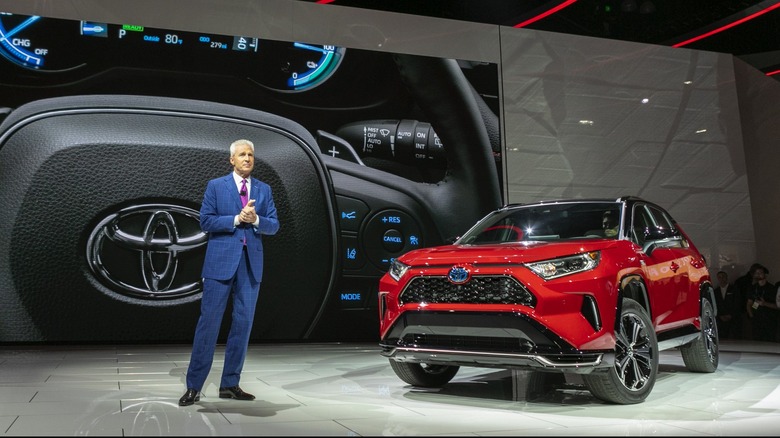3 Reasons We Think The Toyota RAV4 Deserves Its American Sales Success
As soon as the RAV4 hit the U.S. market, it was a major success. Toyota brought its small SUV to the U.S. two years after it launched the vehicle in its home market, Japan. Before the year of its American introduction, 1996, it had already grabbed the favor of Automobile Magazine. The magazine named it "Auto of the Year," and according to The Auto Channel, the editorial director of Automobile Magazine, David E. Davis, said the vehicle was "bringing about a sea change in the way the automobile industry and its customers perceive sport-utility vehicles (SUV)."
Almost three decades later, we've seen proof of that. The RAV4 does one thing really well: make sense. It's large enough to give you extra room while also being compact. Its SUV nature gives it off-road capabilities, it's decently priced, and it is a reliable car.
When the RAV4 was first introduced, it was a 129 hp 2-liter 4-cylinder AWD or FWD compact SUV with either a 5-speed manual or 4-speed automatic transmission. Toyota has continued to perfect this car over the decades, and new RAV4s now come in off-road, hybrid, and luxury trims, but the heart of the RAV4 has stayed the same. By sticking to its roots, Toyota has built success in the U.S. making it among the best-selling cars every year. Going by Statista's findings, it was the most-sold car in the United States in 2022,
It's a reliable, dependable SUV
Toyota's brand hinges on reliability. Of course, its best-selling SUV shares that streak. It is so consistent, in fact, that the RAV4 is rated one of the most reliable Toyota models of all time.
But it isn't perfect; there are some Toyota RAV4 issues that have been prevalent in certain model years. For example, the 2006 to 2008 models are oil-guzzlers because they share the notorious 2AZ FE engine, which some would call one of Toyota's worst engines. Certain RAV4s could also be prone to steering noise issues, while some white ones between 2008 and 2017 bubble up and the paint peels.
That about sums up all the common issues you might find on a car that's been on the market for nearly 30 years. Compared to other SUVs it has to share the market with, those aren't exactly seen as major issues. Furthermore, you would hardly have any issues choosing a RAV4 outside those problematic years.
Great resale value, cost-effectiveness, and fuel economy
By default, Toyota doesn't list the RAV4 as a luxury car. Therefore, it doesn't have a luxury car MSRP. A brand new RAV4 would cost you roughly $30,000 for a base trim, which is similar to other cars you might consider in this range (Honda CR-V, Hyundai Tucson, Kia Sportage, etc.).
Going by Car Gurus' estimates, the average price of a used RAV4 is about $24,000. You could get a 2022 RAV4 for about $29,000, and each year you go back in RAV4 models, the price sheds about $1,000. That means a 2013 RAV4 is about $14,000, which raises a very solid value proposition, seeing as it's one of the most reliable used cars on the market. In tandem with Toyota's reliability, cheap parts, and aftermarket availability, it's such a great deal for someone trying to get around cheaply.
As gas prices have been unstable and risen intermittently since about 2001, many Americans have leaned toward buying vehicles with better fuel efficiency. The RAV4 is one of the vehicles with the necessary fuel economy, especially since it's an SUV. Using the 2019 model as a case study, it's the most sold RAV4, selling about 448,000 units in its year of production. That 2019 RAV4 does about 30 combined mpg, and the hybrid engine version does about 40 combined mpg.
Whenever it's time to let go of your RAV4, you can rest easy knowing it's a reliable, well-sought-after Toyota. Its popularity gives it an excellent resale value.
The RAV4 is a safe, versatile, average C-SUV
One way you could describe the RAV4 is that it's an all-rounder. It's one of those "utility" vehicles where you can't go wrong. It works as a daily get-around for a car with extra space. It also works as a family car for those who need, and off-road trims give the RAV4 the extra ground clearance and off-roading tech you would want should you ever need it for necessary or recreational off-road driving.
Perhaps the ironic thing that makes the RAV4 so special is just how average it is. It's spacious, but not wildly so; it looks good but also in an approachable, everyday way. It has a decent cabin, but it doesn't claim to be luxurious. Toyota has played it safe with this vehicle, and that is reflected in its fairly muted style.
RAV4s generally come in 4-cylinder engines because that's better for fuel economy while meeting commuting requirements. Some generations back, some RAV4s came with a 3.5-liter V6. But it seems unlikely Toyota will return to that because they didn't perform well. Most people buying the car don't need an SUV that can do zero to 60 in about 6 seconds.
Regardless, it's still nice to know you could get the RAV4 in many engine varieties and trims. And you can buy it secondhand too.



